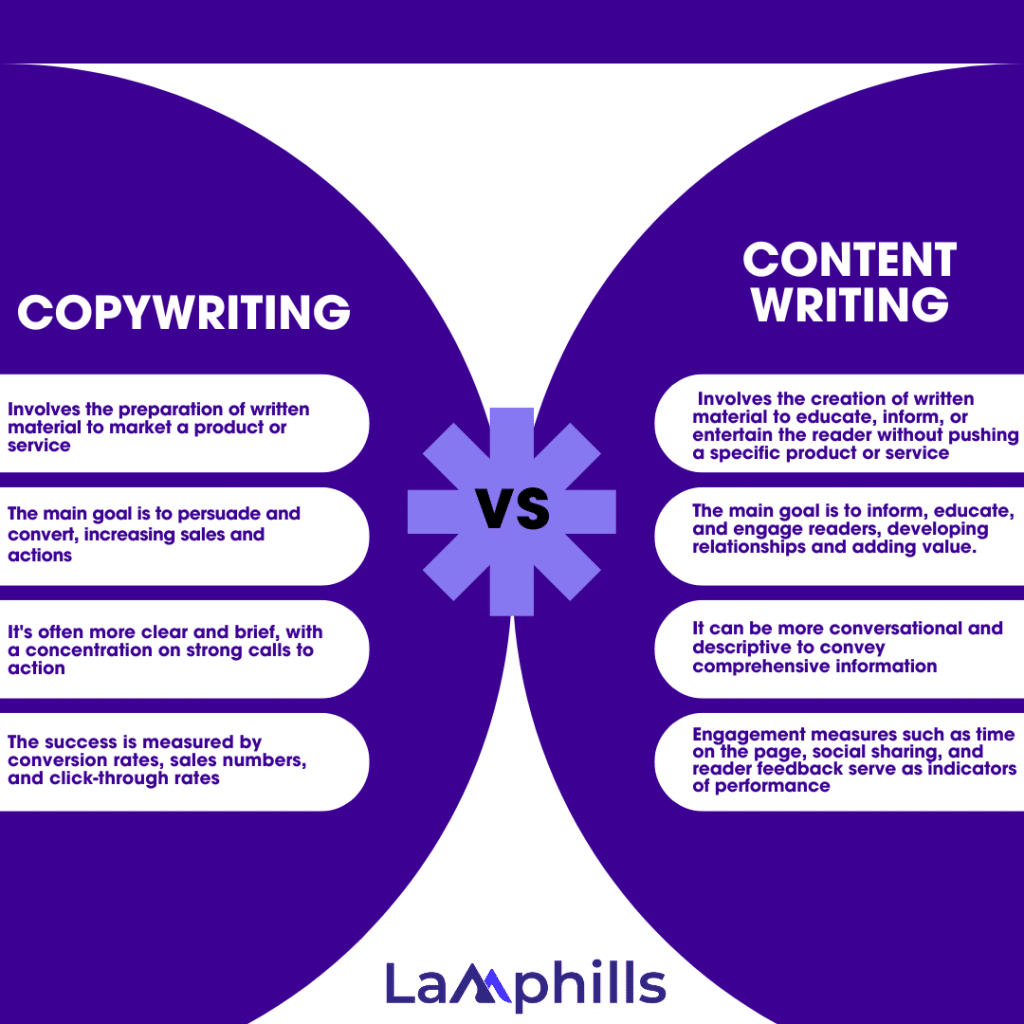When I first started as a writer, I was often perplexed about the distinction between copywriting and content writing. I rapidly discovered that, while both occupations include writing, the skills necessary and possible profits are very different. In this article, I’ll go over the differences between copywriting vs content writing, which skills are more profitable, and give insights that most websites miss. So, if you’re wondering which path will benefit your money, keep reading.
Copywriting vs Content Writing: Definition
What is Copywriting?
Copywriting is the preparation of written material designed to market a product or service. Copywriters meticulously construct text to increase brand awareness and persuade readers to take a specific action, such as making a purchase or subscribing to a service. They can convert product attributes into customer benefits.
Copywriters can produce advertisements, public relations (PR) documents, marketing materials, and website content for print, digital, and audiovisual media. They also gain a thorough grasp of the copy’s intended audience to ensure that it resonates with their wants, needs, and values to elicit action. Copywriters can develop copy for:
- Social media taglines
- Marketing emails
- Commercials
- Print advertisements
- Landing Pages
- Billboards
- Marketing text messaging.
- Website content
- Product Pages
- Radio spots
- Sales letters
- Brochures
What is Content Writing?
Content writing is the creation of written material that intends to educate, inform, or entertain the reader without pushing a specific product or service. They try to create organic online traffic through search engine optimization (SEO). Content writers strive to attract and engage their target audience while also providing value to potential buyers. Brands frequently employ content writing to foster trust and loyalty while also establishing thought leadership in their sector.
Content writing usually entails researching a topic, organizing the facts, making an outline, and then writing the content in an interesting, informative, and easy-to-read fashion. The writers may work for businesses, non-profit organizations, or media outlets, and they may specialize in specific sectors or industries.
Content writers can create:
- Blogs
- E-books
- Whitepapers
- Case Studies
- How-To Guides
- User manuals and documentation.
- Social media content.
- Press releases
- Video Scripts
I started my profession as a content writer, creating blog posts and articles. While I appreciated the creative flexibility, I discovered that the income was frequently smaller than I anticipated. I decided to try copywriting because I was interested in the possibility of making more money.
The move was difficult, but it paid off. My first significant copywriting project paid me three times what I earned from content writing. This encounter exposed me to the earning potential of both vocations.
Copywriting vs Content Writing: Key Differences

#1. Purpose
Copywriting: The main goal is to persuade and convert. It’s all about increasing sales and actions.
Content Writing: The primary objective is to inform, educate, and engage readers. It’s about developing relationships and adding value.
#2. Style and Tone
Copywriting: It’s often more clear and brief, with a concentration on strong calls to action.
Content Writing: It can be more conversational and descriptive to convey comprehensive information.
#3. Measures of Success
Copywriting: The success is measured by conversion rates, sales numbers, and click-through rates.
Content Writing: Engagement measures such as time on the page, social sharing, and reader feedback serve as indicators of performance.
ClearVoice’s poll found that copywriters earn an average of $60 per hour, while content writers earn an average of $40 per hour.
Copywriting vs Content Writing: Skills
Copywriting Skills
- Persuasion: The capacity to persuade readers to act.
- Understanding of Psychology: Understanding what triggers urge people to take action.
- Conciseness: Getting across a powerful point in as few words as feasible.
- SEO Knowledge: Understanding how to write content that performs well in search engines.
- Technical Writing: The ability to provide clear and persuasive technical content as needed.
Content Writing Skills
- Research: The ability to collect and synthesize data from a variety of sources.
- Storytelling: Providing readers with engaging narratives.
- SEO Knowledge: Creating content that performs effectively in search engines.
- Adaptability: Writing in a variety of styles and topics.
- Editing: Ensure that the content is polished and error-free.
Copywriting vs Content Writing: Similarities
But how do you determine if copy and content actually help your marketing efforts?
Recognizing that, despite their differences, they share three traits. By understanding how certain characteristics contribute to an entire marketing strategy:
Consider copywriting and content writing to be complementary. Together, they increase awareness and reputation, ultimately driving sales.
When to Use Copywriting
The simple answer is that copywriting is the most effective tactic for persuasion.
Consider the voice that copywriting emulates—that of a salesperson.
Question: Am I attempting to sell something? If so, a copy is required.
Copywriting: An Example Scenario
Assume you’re preparing to establish a new internet fashion brand called UrbanChic. Its purpose is to appeal to a young, style-conscious clientele.
You also need to write a product description for your flagship denim jacket, which will be shown on a product page in your e-commerce store.
Are you looking to sell or educate?
Certainly the former. So, a copy is required.
If you’re having trouble coming up with a copy due to writer’s block, it’s okay to seek assistance from AI-powered solutions such as ChatGPT. However, all ideas should be treated as directional. Edit and add your own touch to make the copy genuinely unique and brand-safe.
Of course, copywriting isn’t just for product pages or social media postings. So, let’s take a look at some circumstances where copywriting would be important.
- Online ads (in search engines, on website banners, on social media): Copywriting molds the value proposition of a product or service into an eye-catching headline that entices readers to click through to a landing page.
- Landing pages: Well-written text encourages visitors to buy, subscribe, sign up, and so forth. This is how copywriting converts landing page visitors into leads or customers.
- Email marketing: Scroll-stopping subject lines, interesting content, and an efficient CTA are essential parts of copywriting.
- Video scripts: Copywriting appears as engaging conversation, gripping narration, and skillfully employed graphics.
- Product packaging: Copywriting takes the form of short text that communicates the product’s benefits, usage instructions, and the brand’s identity.
- Press releases: Copywriting appears as newsworthy headlines and impactful statements meant to catch media attention and promote a business, product, or event to the public.
Techniques and Strategies for Copywriting
The use of emotional triggers, persuasive language, appealing headlines, compelling CTAs, and search-engine-optimized text are fundamental to effective copywriting.
#1. Emotional Triggers
Emotions play an important role in decision-making. Skilled copywriters take advantage of this by including emotional triggers in their copy.
It may cause sensations of joy or exhilaration. Or even FOMO (fear of missing out).
Words like “exclusive,” or “limited,” for example, can create a sense of urgency or exclusivity, driving potential buyers to make quick selections.
#2. Persuasive Language
Copy persuades readers by appealing to their thinking. It attempts to persuade them of the benefits of a product or service.
Persuasive language can exist in:
- Unique selling points (USPs): “Take snapshots that others can only dream of—through the world’s first 250 MP camera.”
- Testimonies: “See what our satisfied customers are saying about how our fitness program transformed their lives.”
- The facts and figures: “Our energy-efficient appliances can help you save up to 40% on your monthly utility bills.”
- Before-and-after examples: “Imagine yourself with vibrant, youthful skin after just two weeks of following our skin care regimen.”
#3. Enticing Headlines
The headline is the first thing a reader notices about your content. It can make or destroy an engagement.
It should entice the reader to proceed. A well-constructed headline:
- Piques curiosity: “5 Twists to Transform Your Morning Routine”
- Addresses an issue: “Say Goodbye to Clutter: Organize Your Space in Five Steps”
- Provides a solution: “Simplify Tax Season through Automated Accounting.”
#4. Engaging CTAs
Calls to action encourage readers to take the final step toward achieving their goals.
A good CTA begins with an imperative, or the command form of a verb. For example:
- “Join now and begin your journey to a healthier you!”
- “Claim Your Free Trial and Start Your Entrepreneurial Project.”
#5. Text that is optimized for search engines
Only copy that reaches your intended audience may persuade. To ensure that it does, the copy should adhere to SEO-recommended practices such as:
- Satisfying search intent
- Including keywords in titles, headers, and the material itself.
Examples of Successful Copywriting
Many textbook marketing efforts have earned their place in history through excellent copywriting. You are most likely familiar with the brands, and you may have heard of the campaigns:
#1. Apple’s “Think Different” Campaign (1997)
This ad positioned Apple as a brand for individuals who are unique and innovative.
Steve Jobs narrated the campaign’s main advertisement, which began: “Here’s to […] the misfits, the rebels, the troublemakers […]” The word “Here’s to,” in this copy, conveys a tone of celebration and adoration.
It then cites various archetypes, including “the misfits, rebels, and troublemakers,” which create a sense of individuality and resistance to conventional conventions.
By complimenting those who do not fit in, the copy highlights the need to do things differently.
#2. Nike’s “Just Do It” Campaign (1988)
This campaign has become a vital part of Nike’s brand identity.
The “Just Do It” call to action inspires people to overcome hurdles, take risks, and pursue their goals without hesitation.
The phrase is brief and memorable, making it simple to recall Nike’s key values of motivation, drive, and action.
When to Use Content Writing
The easy answer is: employ content writing to give important information while also establishing brand authority.
Consider the mentor’s voice when writing content.
So, ask:
Am I attempting to teach, assist, or relate to the reader? If so, content writing should be the strategy you employ.
Content Writing Scenarios
Content writing, like copywriting, is important in specific situations.
- Blog posts are informative pieces that address themes important to your industry and offer insights and suggestions to your audience.
- How-to guides and tutorials are step-by-step instructions that lead readers through processes and help them reach desired objectives.
- Product reviews and comparisons are detailed evaluations of items or services that highlight their features, benefits, and downsides.
- Listicles are curated lists of things, tips, or recommendations tailored to the unique interests of your target audience.
- Industry analysis: A thorough examination of industry trends, news, and advancements.
- Thought leadership articles are thought-provoking essays that give your unique perspective on cutting-edge themes relevant to your industry.
- Case studies are detailed investigations of specific initiatives, demonstrating how a product or service successfully solved difficulties and generated outcomes.
- Whitepapers and research papers are in-depth publications that delve into challenging topics and deliver unique results.
- Ebooks: Longer-form content that covers a certain subject in detail, allowing readers a comprehensive resource for learning and discovery.
- Podcast and video scripts are written outlines and conversations that serve as the foundation for spoken or visual content.
- FAQs and help center articles are comprehensive pieces that address common questions, usually to help your consumers utilize your product successfully.
- Company news is content that communicates company milestones and successes to keep your audience informed.
Each of these instances requires content writing to give useful information, engage readers, and develop brand authority.
Techniques and Strategies for Content Writing
Good content employs four main techniques: storytelling, solution-oriented teaching, and search engine optimization.
Let’s look at these to help you improve your content writing skills:
- Storytelling: Creating narratives that appeal to the audience while also conveying useful information.
- Focusing on the reader’s concerns and providing solutions.
- Teaching: Whether it’s a lesson, a deep dive into a complicated topic, or a brief explanation, assisting your reader in understanding anything can sometimes provide the most value.
- Optimizing for search engines entails incorporating keywords into your content and writing relevant titles and meta descriptions to guarantee that your audience can find it in the first place.
Examples of Successful Content Writing
Perhaps you have heard of or read the following content articles: If not, we strongly encourage looking at the originals beyond our explanations here:
- “Link Building Case Study: How I Increased My Search Traffic by 110% in 14 Days” presented by Backlinko: The skyscraper technique described in this essay addresses a perennial digital marketing challenge—link building—and provides a solution that has gained popularity. Furthermore, while the piece is structured as a case study that explains the skyscraper technique step by step, it also includes storytelling aspects.
- “21 Best Search Engines in the World [2023]” by Semrush: This listicle addresses another prevalent issue: driving traffic to search engines other than Google. It presents a solution by introducing the reader to 20 different search engines and their features. It also includes mini-stories on how specific search engines rose to prominence in the industry.
Choosing Between Copywriting and Content Writing: Some Advice
If you are unsure whether you want to pursue a career as a copywriter or a content writer, here are some guidelines to help you decide:
- Consider what type of writing you enjoy. If you enjoy creative writing that appeals to people’s emotions, copywriting may be for you. If you appreciate well-researched and authoritative nonfiction writing, content writing could be a good fit for you.
- Consider the atmosphere you prefer. Both content and copywriters can work for advertising agencies, as in-house copywriters for private businesses, or as freelance writers, and the working environment varies by employer. Copywriters’ work is frequently interactive since they collaborate with creative directors, web developers, and graphic designers, whereas content writers typically work separately.
- Be open to either. People frequently transfer between the copywriting and content writing professions since their skill sets and experiences are similar. If you take one path and then decide to pursue the other, you’ll have a portfolio of work and a set of transferable skills to use when applying for new jobs.
Using Templates to Increase Efficiency
To streamline my writing process and ensure consistency, I created templates for copywriting and content writing. These templates help me organize my thoughts and make sure I have included all of the important parts.
Blog Post Template:
Title: An engaging and SEO-friendly title.
Introduction:
- Engage the reader with an interesting fact or question.
- Provide a brief introduction to the issue and its relevance.
The Main Body:
- Section 1: Explain the first essential idea using examples and facts.
- Section 2: Expand on the second major point using personal anecdotes.
- Section 3: Highlight the third major point with quotes from experts.
Conclusion:
- Summarize the major points.
- Include a call-to-action (e.g., ask readers to remark, share, or contact you for further information).
Call to action (CTA):
- A clear and appealing call to action that directs the reader to the next step.
Lamphills-Blog-Post-Template.PDF
Which Skills Generate More Income?
From my experience and analysis, copywriting has a larger earning potential than content writing. This is partly because businesses are ready to pay a higher price for content that directly generates sales and conversions. However, successful content writers can earn a good living, especially if they specialize in in-demand sectors and consistently create high-quality work.
According to CopyPress research, top-tier copywriters can earn more than $100,000 per year, while experienced content writers typically earn between $45,000 and $75,000 annually.
Key Takeaways
- Copywriting typically pays better because it has a direct impact on sales.
- Although there is considerable overlap, copywriting and content writing requires distinct skills and techniques.
- Conversions measure copywriting success, whereas engagement measures content-writing success.
- If you concentrate on a particular area, you can earn more money in either industry.
- Templates can help you streamline your writing process and guarantee that you include all important parts.
Conclusion
Whether you decide to pursue copywriting or content writing, understanding the distinctions and refining the relevant skills can have a big impact on your earnings. Both disciplines have distinct opportunities and challenges, and the ideal path relies on your abilities and interests. Are you more drawn to persuasive writing, or do you prefer to create interesting and informative content? Share your opinions, and we’ll talk about how to navigate the wonderful world of writing.
Related Articles
- Content Writer Job Description: Attracting Top Writing Talent
- What Is Authoritative Content? How It Is Used and Steps To Creating One
- How to Create Promotional Content That Drives Results for Your Brand(Plus Examples)
- The Ultimate Guide To Writing A Winning Content Brief
- 10 Powerful Content Localization Tips from Top Marketing Experts






